STARLOG INTERVIEW/PORTFOLIO
taken from STARLOG/May 1982
BLADE RUNNER'S Sid Mead
An Artist with Designs on the Future
By ED NAHA
Actors Harrison Ford and Edward James Olmos slog their way through a metropolitan
street scene gone haywire. The street is not only a home for some of the
seediest pedestrians seen since Tobacco Road but is populated, as
well, by a tangle of industrial tubing and pipe fixtures. Taxis resembling
tanks chug by. Tenement buildings have their windows blotted out by large
television screens which flash slices of exotic, tropical lifestyles onto
the macadam below.
Ford and Olmos are "hunting" genetically created human replicants on
one of the strangest sets to be created in the history of futuristic films.
The film is Ridley Scott's Blade Runner.
The set is constructed in Hollywood, U.S.A. and much of its nightmarish
ambience arose from the fertile mind of artist Syd Mead. Although he is
not physically present at the Warner Brothers' studio Mead's touch is certainly
felt.
At no time, for instance, does any part of the set conjure up cinematic
memories of such films as Funny Girl or The Way We Were. Yet, this
New York street scene was indeed part of those films, as well as most of
the James Cagney and Humphrey Bogart films produced at Warners during Hollywood's
golden years.
For director Scott's adaptation of Philip K. Dick's novel Do Androids
Dream of Electric Sheep?, the standard New York backdrop had to be
transformed into Any-Metropolis U.S.A., circa 2020.
That's where Mead came in.
A uniquely individualistic graphic artist-turned-consultant-turned
futurist, Mead parlayed a few preliminary sketches into a wide-screen vision
of a near Dystopian tomorrow. Not bad for a fellow not usually associated
with motion pictures.
"I feel pretty responsible for the final look of the film," says Mead
from his West Coast headquarters several months after production has stopped.
"The way the street scenes are dressed is right off my sketches. I walked
around the set one morning and it was like being in one of my drawings.
It was pretty eerie."
Mead's impressive cinematic triumph actually came about quite accidentally.
A commercial artist best known for his futuristic designs for U.S. Steel,
the Ford motor company and other corporations, Mead was lionized by many
science-fiction fans a few years back when a collection of his drawings,
Sentinel, was published. He then was asked to design the inside
of the Voyager craft for Star Trek-The Motion Picture, his lone
film credit before being contacted by director Ridley Scott during Blade
Runner's embryonic period.
"Ridley called and came over to the house with Ivor Powell (the film's
associate producer)," recalls Mead. "They had Chris Fosse's book, Roger
Dean's book and mine. Ridley was aware of my work and when he was shopping
around for special-effects people, he talked with John [Star Wars] Dykstra
who wound up re-enforcing Ridley's opinions about my possibilities."
Mead and Scott hit it off. "Initially, he was interested in me only
in terms of automotive design. Although I had only done a little bit of
work on the Star Trek film, I felt comfortable accepting the assignment.
I don't mind working on vehicles for movies. I'm comfortable with that,
having done it for corporations countless times."
And so, Mead set off to work. Before long, however, he discovered that
it was impossible to ignore the challenge of inventing an entire futurescape
as opposed to just elements within it. "I never like to sketch a vehicle
on a blank page," he shrugs. "I'll toss in back ground settings. I had
read the script to Blade Runner and wanted to give the city a shot.
After some discussions with Ridley and art director Larry Paul, I began
putting in backgrounds that fit the tone of the picture.
Ridley liked them. He had me expand on them and sketch a few street
sets and, then, some mtenor sets. Before it was all over, I wound up working
on the look of almost all the ar ticles in the film from hand-held hardware
to more elaborate articles."
In short order, Mead was immeshed in the laborious process of launching
a motion picture. "To get this movie really rolling in terms of design,"
he says, "it took at least three months. The actual preproduction lasted
a year. That's pretty long. I worked on the vehicles first because they
took the most time. Then, I did the street sets. Then, I did the detailed
objects like coin slots and parking meters... all the gadgetry you need
to make a non-existent society seem realistic down to the last detail.
Ridley is a stickler for detail."
Future Cars
As much as Mead wanted to dive into envisioning a futuristic society, he
labored long and hard on Blade Runner's automotive designs first. "After
all," he laughs, "that's what I was paid for in the first place. I came
up with five basic designs that seemed to please everyone.
"The Spinner is the star vehicle. That's the car that actually
flies. Right from the start, I tried to stay away from stereotypical approaches.
I thought that folding wings and helicopter blades had been done to death
on vehicles in futuristic films. I thought we should think of it as an
enclosed lift vehicle.
"It would look like a car all the time, whether it was flying or just
rolling down a street. That seemed more logical and easier to handle dramatically
than a thing with all sorts of attachments that unfolded or popped out
for take-off. The Spinner was the most expensive vehicle to build
and, dramatically, the most important. In the film, it's only used by authorized
personnel because it flies and, therefore, is involved with complicated,
three-dimensional travel patterns.
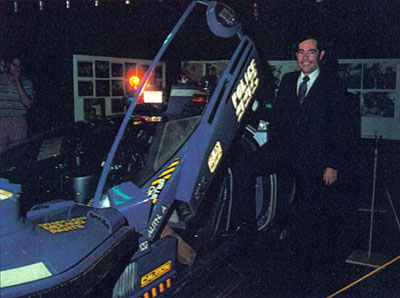 |
Artist/designer Mead stands beside
one of his concepts come-to-life, the Spinner.
"The second most important vehicle was Deckard's [Ford's] sedan. It's
about the size of a contemporary medium-sized car. The theory behind this
model is that it's a decommissioned flying sedan. All the exterior flaps
and air directional panels have been removed and it's now only used for
street travel. It still has all the original bumpers, light patterns and
overbuilt windshield wipers, though. It's a sleek sedan.
"With those two out of the way, I had to come up with a means of mass
transportation, a People's Vehicle. It's a little cart that anyone can
rent or lease. You climb in, insert a card and only pay for the time you
actually use the craft. You drive it and, then, simply leave it in the
street when you're through. Eventually, some other customer walks by, inserts
his or her card, and just zooms off.
"I also had to come up with a pretty crazyquilt kind of design for
Sebastian's van. In the movie, the character of Sebastian is sort of an
electronics wizard, a super-hobbiest and tinkerer. He patches his truck
together by taking a commercial chasis and adding things onto it, making
it an enclosed truck with a bed in the back and everything.
"The trick with Sebastian's van was to come up with something that
looked patched together using pieces that audiences wouldn't recognize
as being available today. I figured that Sebastian could give his truck
a real armadillo look by using a whole bunch of flawed deflector panels
as the basis for a body.
"After that, the film began using a lot of cross-over vehicles. They
took Sebastian's truck and modified it into an ambulance. Deckard's sedan
became the basis of police cruisers and staff cars. There's a bus in the
film that I didn't actually work on but the look was extrapolated from
the style I had already established."
Even while designing the movie's auto horde, Mead was coming up with
ideas about the environment that would make the vehicles both plausible
and necessary. He found his inspiration in contemporary New York.
"The city in the movie is not named," he cautions. "There's no particular
setting. But, let's face it, New York is the example of what's going on
in cities today with buildings going up over 1,000 feet.
"We used that as a springboard. We drew a profile of a city taking
the two World Trade Towers as the norm. We figured that, as you went up
higher, the street level as we know it today would become some sort of
massive service alley sequestered beneath these enormous megastructures.
"That would, in turn, give the streets a sort of subterranean sewer
look. You'd have generators and tubes and gigantic pylons supporting the
sides of those buildings and taking up space on ground level. You might
wind up taking a whole city block, leaving the old building structures
in place, and building a large structure inside that block that would represent
a pylon supporting a 3,000 foot skyscraper. Heck. That single pylon might
extend for several city blocks on the side of the building. Using that
idea, you eventually come up with a street filled with a lot of stuff.
It would be transformed into a maze of pipes and tubes.
"By inference, the crime and the congestion present on this ground
level would be an enormous problem, making, it almost necessary for all
decent citizens to avoid it, to not venture below the 40th level of the
megastructures. The streets would really be low, in every sense of the
word.
"That sort of low crime vs. an elevated society would lead to
the creation of a second level of between-building accesses for normal
citizens; freeways and people carriers looming high above the original
street level. In essence, you'd have a second society built upon the remains
of a past one."
Artis/Philosopher
Quite heady stuff for a designer. Listening to Mead speak, one wonders
if he was hired to sketch or philosophize. In Mead's mind it's all part
of the same process.
"I approached Blade Runner as a classical industrial design
exercise," he says. "We reinvented things to solve the problem; the problem
being the script.
"The script called for us to come up with new ideas that would support
the action realistically. We had to come up with objects that looked
like what they were supposed to be. In corporate work, when you're
asked to design the inside of a train or a plane, the problem is clearly
delineated for you. In that type of work, however, you're dealing with
reality. For this film, I had to invent things that might not be realistic
by contemporary standards, but fit the dramatic reality of the story. In
essence, everything had to have a dramatic, emotional or technological
reason for being.
"For instance, the state of the art today for entry into an enclosed
space is through the use of a little plastic card that has a magnetic code
buried in the plastic. That card, however, isn't very dramatic visually.
It doesn't look like it's doing anything special to allow you into that
enclosed space.
"So, for the movie, we invented little 'keys' that lit up and rolled
down something that resembled a watch fob or a key chain. You roll this
little wheel down a fob and if the lights twinkle in the right sequence,
you're allowed to enter the room. It's waaay past what you'd actually
need, but it's more visually intriguing for the purpose of plot."
Also on tap for Blade Runner are parking meters (at three bucks
per minute) that give off a red glow when your time is up and deep fry
your hands should you try to cross them; pollution control devices for
the tops of cars; a Voight-Kampf machine that measures "empathy" and a
series of tools used by Deckard in tracking down renegade replicants.
Despite the forboding atmosphere depicted in Blade Runner's vision
of the future and Mead's enjoyment in the work, he does confess, "This
is someone else's story. I was hired to visually represent it according
to the dictates of the script. Personally, I don't see the future going
that way. I'm an optimist."
In Mead's eyes, cities will flourish, not decay, in years to come.
"I know that we're going to have 3,000 foot buildings," he declares.
"That idea jibes with the current trends of enclosing space. But I think
that, once you're inside the future skyscraper, the building will represent
a variety of spaces from parks and zoos to business centers. Right now,
we're just building artificial cliffs in cities, dull structures.
"In the future, we'll probably go back to the concept of artfully constructed
vistas that will take some of their cues from nature. We all like nature's
randomness in terms of design. We like that visual variety. If everything
becomes architecturally too streamlined or cubistic, there will be a negative
effect on people. It won't seem human. The architecture of the future
will have to be very creative.
"I see the next generation of people growing up being able to contribute
to that creative element. They will be much less intimidated by technology.
Right now, technology is hamstrung because of the so-called flower children;
the 1960s youth who are now in their 30s and 40s. Right now, I believe
what we're experiencing is the last wave of technology-inspired paranoia
as this final remnant of the hippie generation moves into politics.
"They're the last group of sad, disillusioned people who just can't
figure out how to bridge the gap between a thoroughly technologically supported
natural society and the old industrial revolution machinery. Technology
isn't a villain. Even in our movie, the robot replicants are actually people."
Mead sincerely believes that society's wellbeing depends on humanity's
pushing for a more productive lifestyle through the use of technology.
"Nature isn't really very efficient," he says. "I've always been fascinated
with organic/mechanical crossover." He talks for a few minutes about new
developments in protein-molecule computers before returning to the subject
of his film career. With Blade Runner now part of past history,
Mead is turning to a few new movie assignments while keeping in touch with
the corporate design world. He's not in the field of design for the glamour.
His biggest reward lies in solving a problem. "I don't really have to see
my designs rolling down the street in order to be fulfilled," he states.
He pauses for a moment before reconsidering, "But there IS one scene
in Blade Runner... The Spinner takes off from the street.
It's moving down the block. The rain is falling, illuminated by all this
strange lighting. The scene is really a moving sketchbook of all the designs
I did for the film; vehicles, buildings... everything." He finds himself
lost in visualizing that single segment of the movie and says with a laugh,
"It's pretty super."
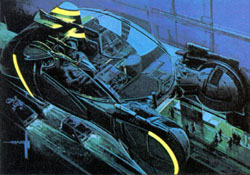
Concept art showing a Spinner airborne. |
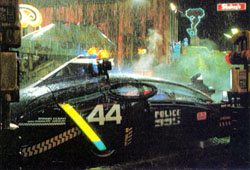
From the film: the Spinner sits in surface traffic. |
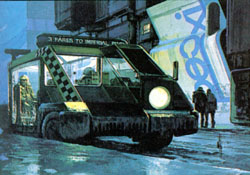
Concept art for new ciry cab. |
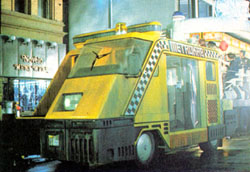
From the film: "Metrokab" awaits passengers. |
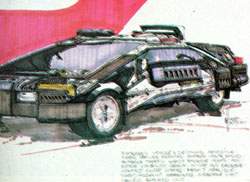
Concept for Deckard's vehicle: A grounded Spinner. |
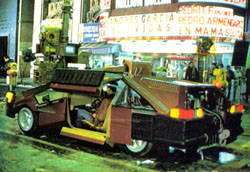
From the film: An almost perfect realization. |
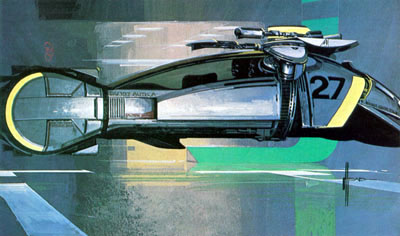
Concept art for one of Mead's finest creations-the Spinner.
It's a unique flying-car desing, having no wings or stabilizer fins. It
was the most expensive and complicated prop in the film. Mead calls it
an "enclosed lift vehicle." |
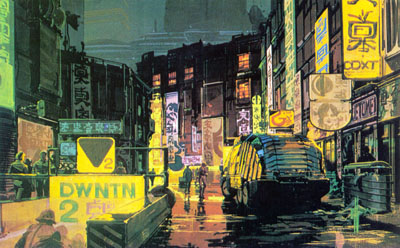
A typical downtown scene in the Blade Runner mega-city.
Mead designed the vehicles first and tehm took a shot at a city. The vehicle
on the right is Sebastian's van. Mead describes Sebastian as "an electronics
wizard and tinkerer." |
Go back to main page.